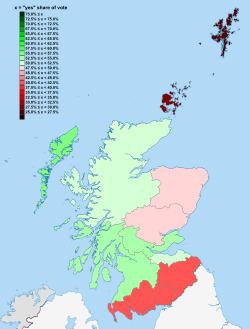Yes 1,230,937 Valid votes 2,384,439 Location Scotland, United Kingdom | No 1,153,502 Date 1 March 1979 | |
 | ||
1,230,937 7001516200000000000♠51.62% 1,153,502 7001483800000000000♠48.38% 2,384,439 7001998700000000000♠99.87% | ||
The Scottish referendum of 1979 was a post-legislative referendum to decide whether there was sufficient support for a Scottish Assembly proposed in the Scotland Act 1978 among the Scottish electorate. This was an act to create a devolved deliberative assembly for Scotland. An amendment to the Act stipulated that it would be repealed if fewer than 40% of the total electorate voted Yes in the referendum. The result was that 51.6% supported the proposal, but with a turnout of 64%, this represented only 32.9% of the registered electorate. The Act was subsequently repealed.
Contents
Background
In 1976, the UK's Labour government led by James Callaghan, which had won the previous general election in 1974 by just three seats, had lost its parliamentary majority entirely following a series of adverse by-election results. To recreate a voting majority in the House of Commons, the government made an agreement with the Scottish National Party and Plaid Cymru whereby, in return for their support in Commons votes, the government would instigate legislation to devolve political powers from Westminster to Scotland and Wales. This in turn followed the findings of the Kilbrandon commission which had recommended the establishment of a separate Scottish parliament.
The Scotland and Wales Bill was subsequently introduced in November 1976, but the government struggled to get the Bill through parliament. The Conservative opposition opposed its second reading and on the first day of committee 350 amendments were put down. Progress slowed to a crawl. In February 1977 the Bill's cabinet sponsor Michael Foot tabled a Guillotine Motion to attempt to halt the delays. The motion was rejected and the government was forced to withdraw the Bill.
Scotland Act 1978
The government returned to the issue of devolution in November 1977. Separate bills for Scotland and Wales were published and support from the Liberals was obtained. In spite of continued opposition requiring another guillotine motion, the Bills were passed. During the passage of the Scotland Act 1978 through Parliament, an amendment introduced by Labour MP George Cunningham added a requirement that the approval at the referendum be by 40% of Scotland's total registered electorate, rather than by a majority.
Proposed Assembly
Had the Scotland Act 1978 entered force, it would have created a Scottish Assembly with limited legislative powers. There would have been a Scottish Executive headed by a "First Secretary", taking over some of the functions of the Secretary of State for Scotland. Meetings of the Scottish Assembly would have been held at the Old Royal High School in Regent Road, Edinburgh. The former school hall was adapted for use by the Scottish Assembly, including the installation of microphones and new olive green leather seating. Members would have been elected by the "first past the post" system.
The Scottish Assembly would have had the power to introduce primary legislation to be known as "Measures" (rather than Acts) within defined areas of competence. This form of legislation would not receive royal assent like Acts of Parliament do. Instead, the legislation is signed via an Order in Council, which the monarch signs and appends to the assembly measure once passed. Some other new offices would have been created, such as a Comptroller and Auditor General for Scotland.
The areas of responsibility included:
Responsibility for agriculture, fisheries and food would have been divided between the Assembly and the United Kingdom government, while the latter would have retained control of electricity supply.
By counting area
Source: Glasgow Herald, House of Commons Library.
Aftermath
The result was a narrow majority in favour of devolution. A total of 1,230,937 (51.6%) voted at the referendum in favour of an Assembly, a majority of about 77,400 over those voting against. However, this total represented only 32.9% of the registered electorate as a whole. The Labour government accepted that the Act's requirements had not been met, and that devolution would therefore not be introduced for Scotland.
In the wake of the referendum the disappointed supporters of the bill conducted a protest campaign under the slogan "Scotland said 'yes'", officially launched in a Glasgow hotel on 7 March 1979. In particular, the Scottish National Party (SNP) carried out a survey of the electoral register in the Edinburgh Central constituency. This appeared to show that the register was so out of date that even in an area where major support for a "yes" vote might be expected, achievement of 40% of the electorate was virtually unattainable. This was because the majority of electors lived in older tenements or newer Council blocks of flats where flat numbers were not specified. The work of electoral registration staff to obtain an accurate current register was almost impossible.
Under the terms of the Act, it could then be repealed by a Statutory Instrument to be approved by Parliament. However, the government's decision to abandon devolution for Scotland led the SNP to withdraw its support for the government. A subsequent vote of no confidence led to the resignation of the Callaghan government, and an election was called. The vote to repeal the Act did not happen until 20 June 1979, by which time a Conservative government had come to power under Margaret Thatcher.
A second referendum to create a devolved legislature in Scotland was held in 1997, which led to the enactment of the Scotland Act 1998 and the creation of a devolved Scottish Parliament in 1999.
